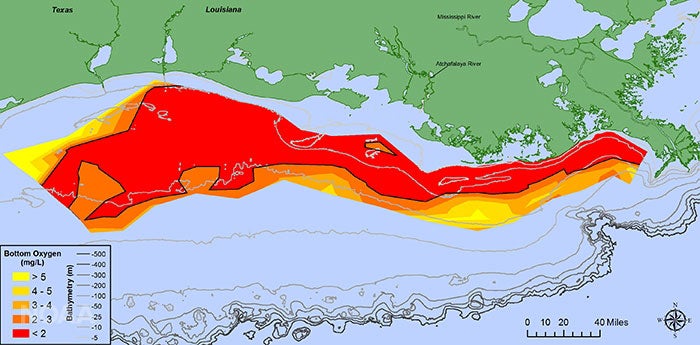Scientists find polluted sea 'dead zone' that is bigger than Wales
The area of oxygen-starved sea is the largest ever found in the Gulf of Mexico

Your support helps us to tell the story
From reproductive rights to climate change to Big Tech, The Independent is on the ground when the story is developing. Whether it's investigating the financials of Elon Musk's pro-Trump PAC or producing our latest documentary, 'The A Word', which shines a light on the American women fighting for reproductive rights, we know how important it is to parse out the facts from the messaging.
At such a critical moment in US history, we need reporters on the ground. Your donation allows us to keep sending journalists to speak to both sides of the story.
The Independent is trusted by Americans across the entire political spectrum. And unlike many other quality news outlets, we choose not to lock Americans out of our reporting and analysis with paywalls. We believe quality journalism should be available to everyone, paid for by those who can afford it.
Your support makes all the difference.Scientists have found a polluted ‘dead zone’ of ocean that is larger than Wales and the biggest ever recorded in the Gulf of Mexico.
The US National Oceanic and Atmospheric Administration (NOAA) said that this year’s Gulf of Mexico dead zone consisted of 8,776 square miles of oxygen-starved sea, covering an area significantly bigger than the 8,020 square miles of Wales.
The dead zone forms annually, mainly because of farm fertiliser pollutants washing into the Atlantic from the Mississippi River, but this year’s affected area was the largest since recording began in 1985.
The environmental campaign group Mighty Earth has blamed the meat industry for the dead zone, claiming much of the nitrate and phosphorous pollution came from fertiliser used in producing vast quantities of corn and soy to feed meat animals.
It singled out the supply chain of Tyson Foods, America’s largest meat company, for particular criticism, but the firm hit back, with a spokeswoman disputing the claims and insisting the Arkansas-based multinational was committed to protecting the environment.
The spokeswoman added: “It’s true the livestock and poultry industry is a major buyer of grain for feed, however, [Mighty Earth] fails to note that a large percentage of corn raised in the US is used for biofuel and that a significant portion is used for human consumption.”
Scientists believe the pollution affecting the Gulf of Mexico comes from fertiliser spread on fields in America’s Upper Midwest. Rain washes nitrogen and phosphorous nutrients from the fertiliser into nearby streams and rivers, which eventually feed into the Gulf of Mexico.
Once in the sea, the nutrients stimulate massive growths of microscopic algae called phytoplankton. These then die, sink to the seafloor, and decompose, stimulating a burst in bacterial growth.
These bacteria consume not just the algae, but also much of the oxygen in the sea. The resulting hypoxia – low oxygen – means that marine life forms that can’t or don’t move are at risk of suffocating.
Don Scavia, a professor of environment and sustainability at the University of Michigan, who was one of the first to raise fears about the dead zone, described it as a hidden environmental disaster.
“It's 8,000 square miles of no oxygen,” he said, “That can't be good!
"Fish that can swim will move out of the way. Organisms that are living on the bottom, that the fish feed on, can't move, and they often die."
In a statement about this year’s dead zone, the NOAA listed environmental and economic impacts that included: “loss of fish habitat, decreased reproductive capabilities in fish species and a reduction in the average size of shrimp caught … which led to short-term economic ripples in the Gulf brown shrimp fishery.”
This year’s dead zone was expected to be large because there had been unusually heavy rainfall in the Midwest, washing more pollutants into waterways.
Previously the largest Gulf of Mexico dead zone was 8,497 square miles, measured in 2002.
For the past five years the average size of the dead zone has been about 5,806 square miles – but this is still three times larger than the target of 1,900 square miles set by the Gulf Hypoxia Task Force, a group which includes US federal and state agencies.
As part the task force’s "action plan" to reduce the size of the Gulf of Mexico dead zone, it is encouraging farmers to plant wide grassy strips alongside streams to block the path of fertiliser runoff before it can get into the waterways.
Dr Scavia, however, has said such voluntary measures are insufficient. He argued that the Gulf of Mexico should be covered by the same kind of legally-binding targets as those in force in the Chesapeake Bay area in Maryland and Virginia.
Chesapeake Bay had a similar dead zone problem, but in 2010 – despite fierce opposition from the farming industry – the US national government imposed targets to limit the amount of pollutants entering the bay.
After state authorities spent billions of dollars on meeting the targets, pollution in Chesapeake Bay reduced and wildlife started to show signs of recovery.
Join our commenting forum
Join thought-provoking conversations, follow other Independent readers and see their replies
Comments